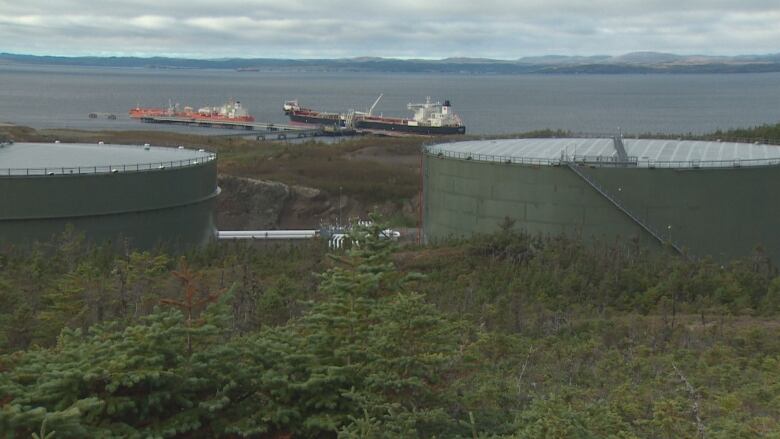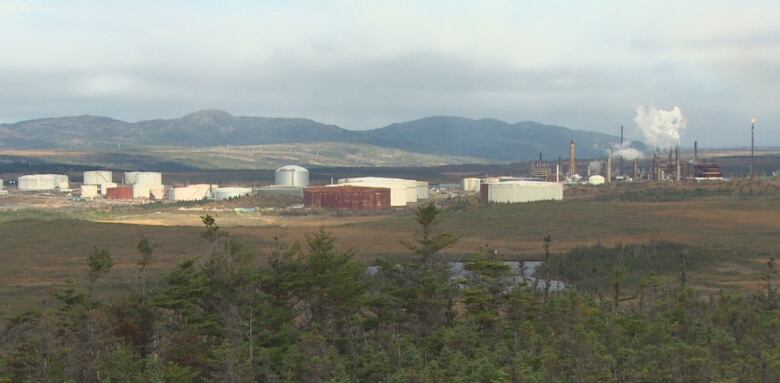Why the Come By Chance refinery has its eye on an overland pipeline to a transshipment terminal
North Atlantic says connector will improve supply, and make N.L. oil more marketable to the world

Oil produced in Newfoundland and Labrador's offshore could soon be flowing through a new pipeline connecting the transshipment terminal in Arnold's Cove and the nearby refinery in Come By Chance.
That could mean a security of supply for the refinery, better access for the province's oil to international markets, and important redundancies in the event of interruptions related to damage or maintenance.
North Atlantic Refining Limited, which owns the refinery, is proposing to construct a 2.5-kilometre overland pipeline between two facilities in Placentia Bay that help form the backbone of the province's oil industry.
Oil from the province's four producing fields is transported by a fleet of three shuttle tankers to the Newfoundland Transshipment terminal at Whiffen Head, where it is then loaded onto larger tankers and shipped to international markets.
Within view of the terminal is the province's only refinery, but despite that close proximity, it's not always easy for the refinery to procure that oil from the Grand Banks.

But a pipeline, at a cost of between $7 million and $8 million, could change that, said North Atlantic CEO Thomas Jenke.
"We (will) have a greater access to the reservoir of the provincial crudes," Jenke told CBC News in an interview Tuesday.
Larger carrier cannot dock at Whiffen Head
The pipeline will also allow Newfoundland oil to be loaded aboard larger tankers — known as very large crude carriers, capable of carrying up to two million barrels of oil — that are capable of docking at Come By Chance, which would make it more economical to transport the oil to distant markets such as Asia and Australia.
Those massive ships cannot dock at the transshipment terminal.
"That is very much in the interest of the province," Jenke said, pointing to the provincial revenue benefits related to oil sales.

Some oil from Hibernia is offloaded directly at the refinery, including a shipment of 750,000 barrels that arrived this week, and is now being refined into everything from gasoline and diesel to propane and jet fuel.
But with the added production from the new Hebron field, the supply is sporadic because of limited space on the shuttle tankers.
So North Atlantic wants to correct that.
Flowing in both directions
The plan is to build a pump station at both locations, allowing oil to flow in both directions. The pipeline will have a diameter of 42 inches, or more than 100 centimetres, with a maximum daily flow rate of more than one million barrels.
Jenke said the company is in talks with the province's environment department, but he's confident it will be approved.
"There's no population in the area. We're going overland. I mean, it's all very much preserved," he said.
The refinery and the transshipment terminal are the two largest onshore oil facilities in the province, and share a common boundary. So the pipeline will not cross any third-party land.
North Atlantic says the pipeline will provide "operational insurance" for both operations.
"With the existence of a connecting line, either party will be able to schedule additional maintenance and inspection work on their respective marine terminals without facing a prolonged outage period," reads a project document submitted to the environment department.

In a statement, Natural Resources Minister Siobhan Coady said the refinery has a long history in the province and generates significant economic and employment benefits.
"This proposed project demonstrates an ongoing commitment on behalf of the company to continue to invest in our province and to use oil from Newfoundland and Labrador if possible," the statement reads.
A decision from Environment Minister Derrick Bragg is expected next month.
Newfoundland Transshipment Limited, meanwhile, is not commenting on the proposal, except to say, "NTL would explore any business opportunities that are deemed important to our customers."

